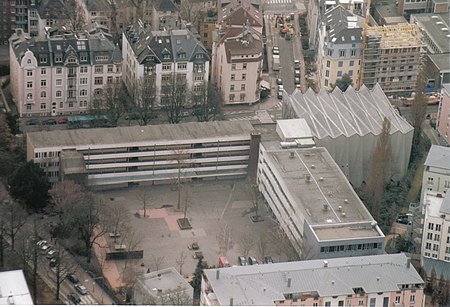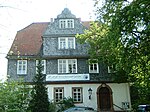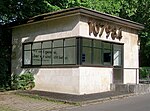The IG Farben Building – also known as the Poelzig Building and the Abrams Building, formerly informally called The Pentagon of Europe – is a building complex in Frankfurt, Germany, which currently serves as the main structure of the West End Campus of the University of Frankfurt. Construction began in 1928 and was complete in 1930 as the corporate headquarters of the IG Farben conglomerate, then the world's largest chemical company and the world's fourth-largest company overall.The building's original design in the modernist New Objectivity style was the subject of a competition which was eventually won by the architect Hans Poelzig. On its completion, the complex was the largest office building in Europe and remained so until the 1950s. The IG Farben Building's six square wings retain a modern, spare elegance, despite its mammoth size. It is also notable for its paternoster elevators.The building was the headquarters for production administration of dyes, pharmaceutical drugs, magnesium, lubricating oil, explosives, and methanol, and for research projects relating to the development of synthetic oil and rubber during World War II. Notably IG Farben scientists discovered the first antibiotic, fundamentally reformed medical research and "opened a new era in medicine." After World War II, the IG Farben Building served as the headquarters for the Supreme Allied Command and from 1949 to 1952 the High Commissioner for Germany (HICOG). Notably Dwight D. Eisenhower had his office in the building. It became the principal location for implementing the Marshall Plan, which supported the post-war reconstruction of Europe. The 1948 Frankfurt Documents, which led to the creation of a West German state allied with the western powers, were signed in the building. The IG Farben Building served as the headquarters for the US Army's V Corps and the Northern Area Command (NACOM) until 1995. It was also the headquarters of the CIA in Germany. During the early Cold War, it was referred to by US authorities as the Headquarters Building, United States Army Europe (USAREUR); the US Army renamed the building the General Creighton W. Abrams Building in 1975. It was informally referred to as "The Pentagon of Europe."In 1995, the US Army transferred the IG Farben Building to the German government, and it was purchased by the state of Hesse on behalf of the University of Frankfurt. Renamed the Poelzig Building in honour of its architect, the building underwent a restoration and was opened as part of the university in 2001. It is the central building of the West End Campus of the university, which also includes over a dozen other buildings built after 2001.










